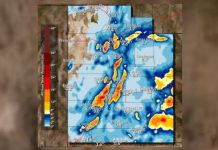
Nov. 26 (UPI) — Snow, rain and gusty winds are set to trigger a travel nightmare up and down the West Coast on the busiest travel day of the year, with travel woes likely to continue into Thanksgiving Day as a ferocious “bomb cyclone” hits the region.
Weather watches, warnings and alerts peppered the western half of the nation as the storm began to make its impacts felt on Tuesday. The storm, AccuWeather forecasters are warning, could be historic in its strength and scope.
An early-week storm, which brought heavy snow to the Denver area and wind gusts of 70 mph to 80 mph to the Los Angeles area on Monday night, according to the NWS, set the stage across much of the West, allowing for a winter-like chill to be entrenched across the Northwest and into much of California and Nevada. This included a small thunderstorm that dropped hail across part of the Seattle area.
The more potent storm will ramp up Tuesday night in southern Oregon and Northern California, and then will dive southward into Arizona and Utah through Thursday.
The wet weather, combined with gusty winds across the state will cause travel concerns for much of the region on Wednesday and Thursday.
“This storm threatens to bring rain and mountain snow to much of California, including places like San Francisco and Sacramento, places that were largely spared by the past week’s rain,” said AccuWeather senior meteorologist Brian Thompson.
The storm could also flirt with all-time low-pressure records in California and Oregon as the center of the system moves inland and could be the strongest storm, in terms of barometric pressure, to hit the region since 2010, according to NOAA’s Weather Prediction Center.
The Weather Prediction Center is forecasting barometric pressure to plunge from 1,018 millibars, the level it was recorded on Monday night, to 976 mb by Tuesday night. That would be a drop of 42 mb in fewer than 24 hours, far exceeding the requirement of a 24-mb drop in 24 hours — the National Weather Service’s threshold for an official “bomb cyclone.”
“Even if it doesn’t break all-time records, the storm very well could be the strongest to ever hit parts of the West Coast during the month of November,” AccuWeather meteorologist and social media manager Jesse Ferrell said.
While burn scar areas may experience flooding and mudslides, travel woes are anticipated with the rounds of heavy rain expected for the Los Angeles Basin.
Slick roadways will be a concern for motorists in places like Santa Barbara, Los Angeles and San Diego from Tuesday night through Thursday night.
More than 55 million travelers are expected between the weekends before and after Thanksgiving, according to the American Automobile Association.
San Francisco’s worst travel time is expected between 2 p.m. and 4 p.m. on Wednesday, by which time the city’s heaviest rain is expected to be over. However, for Los Angeles, the estimated timeframe for most travelers is 5 p.m. to 7 p.m. on Wednesday, when periods of rain are expected to continue.
In addition to the impacts the rain will have on the region, the cold coming in with this storm will allow for high snowfall accumulations that can contribute to the travel disruptions.
With snow levels, down to around 4,000 feet, feet of snow will pile up in the Sierra Nevada of California. Some parts of the Sierra Nevada mountains could see an AccuWeather StormMax of up to 42 inches of snowfall. Snow will even reach as far south as the Peninsular Mountains in Southern California.
Along Interstate 5, just north of the border between California and Oregon, over Siskiyou Summit, slippery conditions are expected for travelers through Wednesday night.
Donner Pass, along Interstate 80, is expected to receive heavy snow, leading to travel delays. Conditions will deteriorate quickly over the summit during Tuesday night with the risk of motorists becoming stranded. A foot or more of snow is forecast from the storm.
Farther south, snow will dip down to the passes north and northeast of Los Angeles on Wednesday and Wednesday night.
Outside of California, snow will spread across Oregon into Nevada, Idaho and Utah. Snowfall accumulations will very much depend on elevation in these areas, although some of the highest snowfall totals could be in southwestern and northern Utah.
Winter storm watches and warnings have been issued for many of the mountains across the region ahead of the storm’s arrival.
Snow will also stretch into Arizona, starting in northwestern parts of the state late Wednesday night, then spreading across the northern two-thirds of the state into Friday.
Just a little more than 6.5 inches of snow fell in Flagstaff with the last storm that moved through the region, with another dose of snow likely for the middle and end of the week. The higher terrain around the region could have a fresh foot of snow before the end of the month.
Snow showers across Arizona, Utah and western Colorado may linger as late as Friday morning, continuing to add to any snowfall totals.
Parts of New Mexico will also get in on the wintry weather.
A stream of moisture from Mexico will arrive in New Mexico and western Texas late Wednesday and Wednesday night, bringing a swath of snow, wintry mix and heavy rain.
Several inches of snow are possible across New Mexico, and a wintry mix can occur in parts of the northern Texas Panhandle and Oklahoma Panhandle before the storm moves into the central Plains.
The last time Amarillo, Texas, observed one inch or more of snow on Thanksgiving was in 1958 when exactly one inch fell. If enough cold air filters in Wednesday night into Thursday morning, there is a chance it could happen again.
The storm is expected to move eastward during the final days of November and cause more travel disruptions for those in the Plains and East heading home following the Thanksgiving holiday.
Behind both of these storms, a winter-like chill will settle into places west of the Rockies. Those out and about on Black Friday and through the weekend will need to bundle up to protect themselves from the cold.
“A second storm is expected to move into the West later on Saturday, and could bring both snow and rain for much of the region through Monday,” said AccuWeather Meteorologist Randy Adkins.
With the potential for another several feet in the Sierra mountains, and locally heavy rainfall in the southern terrain, early indications are that travel conditions could again be difficult for those traveling for the holiday weekend.






